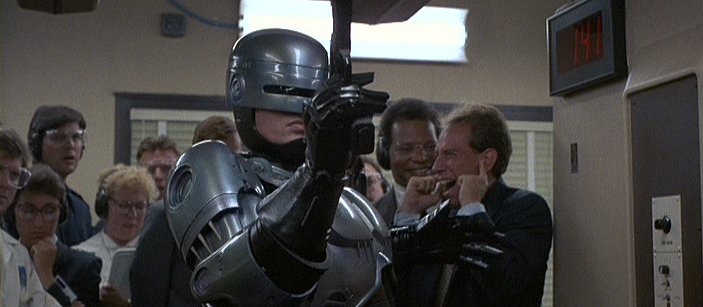
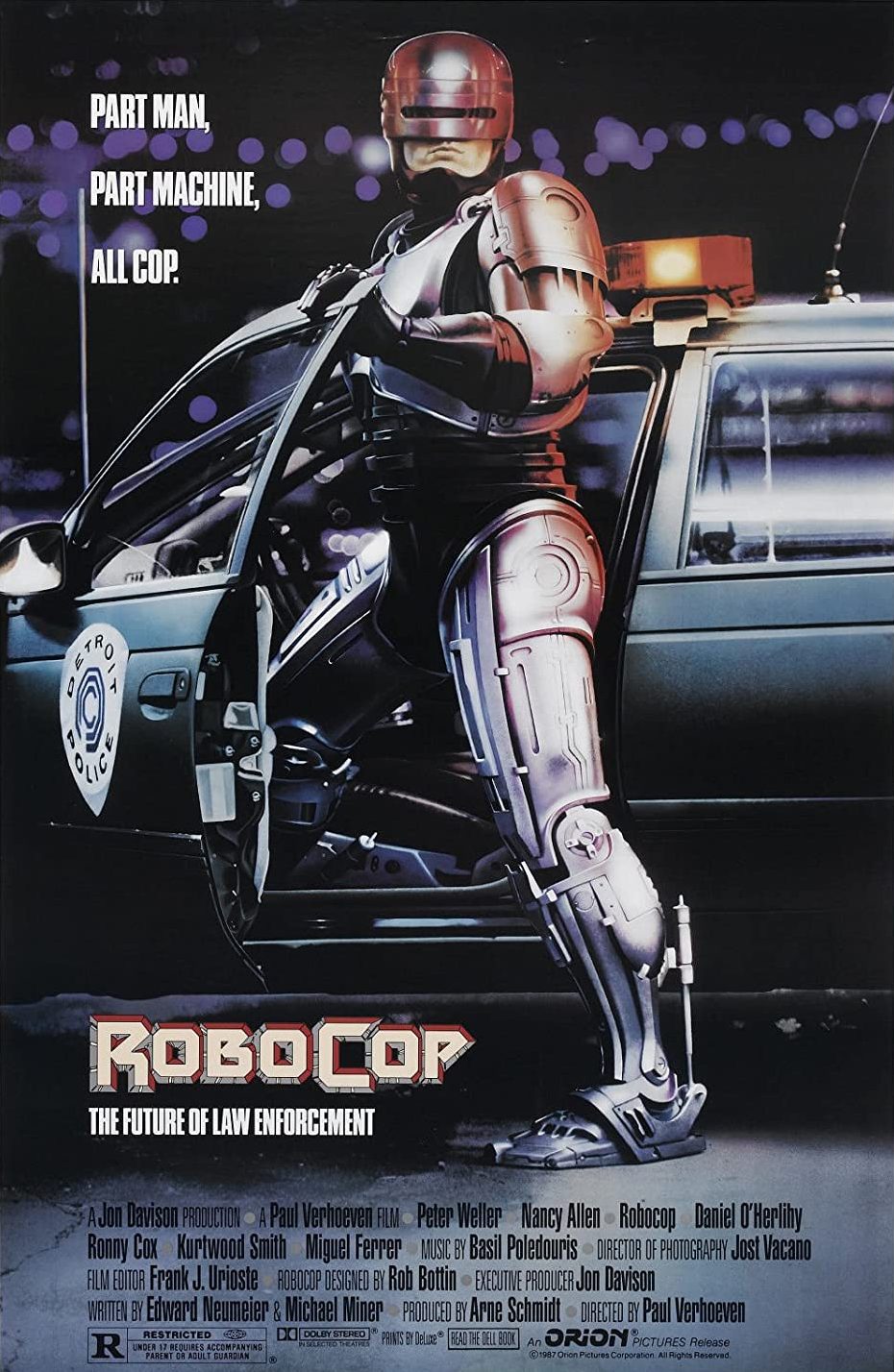
“Serve the public trust, protect the innocent, uphold the law.”
RoboCop is a movie that works on multiple levels. On its cyberpunk surface we see a cheesy, raunchy, gory sci-fi actioner exemplified by grenade launchers, blood squibs and f-bombs. It can surely be enjoyed on those simple terms, but beneath that pulpy layer—and emphasized by its lens—is a biting satire that takes jabs at various capitalist malignancies and first-world anxieties. At the same time that Director Paul Verhoeven and writer Edward Neumeier fix their brutal gaze on ladder-climbing corporate executives and mindless consumers, they also tell a very human story of a man who loses his identity amidst a surfeit of robotic appendages.
In our current era of data analysis and algorithm-informed productions, big studios prefer the PG-13 rating to R. But in the 1980s and ‘90s, a surprising number of big budget films were tagged with the latter. RoboCop upped the ante, receiving an X rating ELEVEN times by the MPAA before the gradual reductions in gore and the introduction of humorous (read: satirical) commercials to break up the absurdly violent action were considered acceptable.
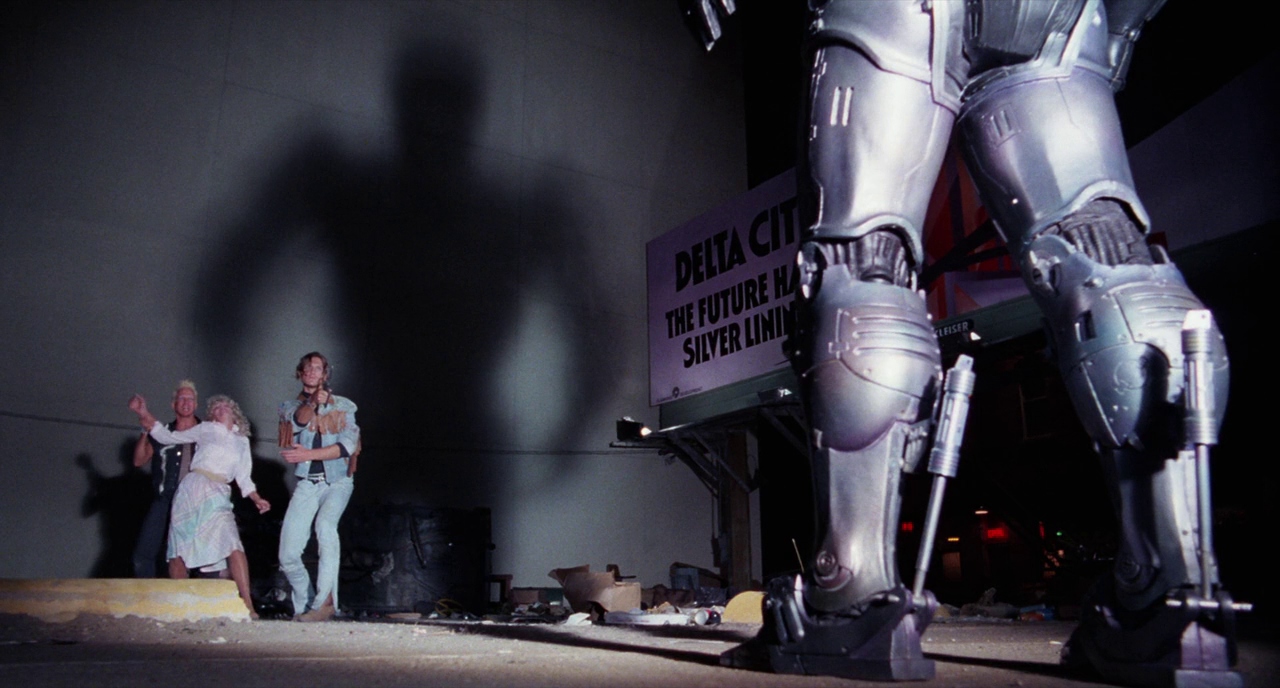
The film quickly sets its unique tone by putting us into the corporate boardroom of Omni Consumer Products. Dick Jones (Ronny Cox), “Number 2” at the company, explains that OCP has signed a contract with the crime-ridden city of Detroit to take over their police force. In exchange, OCP will be allowed to rebuild rundown portions of the city into their own version of utopia. The contract synergizes perfectly with the new product they have been developing in secret—ED-209, a bipedal law enforcement robot. To demonstrate ED-209’s capabilities, Jones prompts a young brownnoser to step up as a volunteer. “Use your gun in a threatening manner,” Jones tells him, handing him a hand cannon. The young man points it at Jones. “Point it at ED-209,” Jones says with exasperation. He does so, and the robot menacingly warns him. “Please put down the weapon. You have twenty seconds to comply.” Everyone is impressed, and the youngster lays the gun down. ED-209 growls at him. “You now have fifteen seconds to comply,” ED-209 says. Technicians frantically pull at cords and look at graphs as the man scrambles around the boardroom, searching in vain for someplace out of ED-209’s line of fire. When the countdown ends, ED-209 unloads copious amounts of lead into the man’s body, ripping him to shreds atop the gleaming white mock-up of the future utopian city. It’s a perfect encapsulation of corporate hubris, socialist dystopia, and desensitization. It still functions perfectly fine narratively even if you don’t pick up on any of that, but it’s almost impossible to miss.
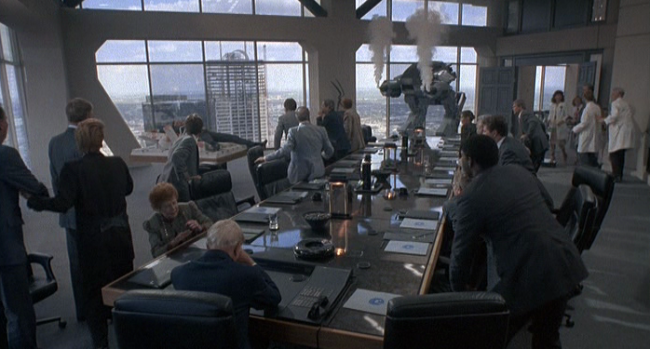
As the shocked executives make their way out of the boardroom, Bob Morton (Miguel Ferrer) makes his pitch to The Old Man (Dan O’Herlihy), filling him in on the RoboCop program that his team had developed as a contingency against hiccups such as the one they just witnessed. He commits to a prototype of the RoboCop program within ninety days. In the meantime, Agent Alex Murphy (Peter Weller) is conveniently ground into a pulp by a group of trigger-happy gangsters led by Clarence Boddicker (Kurtwood Smith—yeah, Red from That ‘70s Show). Just like the earlier shocking scene, Murphy’s death is shown in all its gruesome detail, beginning with a slow-motion removal of the hand via shotgun.1
The story concerns the interwoven fates of the ruthless profiteer Jones, go-getter Morton, and the merciless Boddicker, whose high-stakes relationships are knocked out of balance by the rise of the RoboCop and his personal search for identity. Jones is a heartless psychopath who doesn’t care whether ED-209 functions properly or not because there is money in service parts; who is happy for the chance to expand the city because that means more drugs, more gambling, more prostitutes. Morton, on the other hand, finds a thrill in the high-rolling lifestyle. He is the type who revels in the challenge of climbing the corporate and social ladders; the type who has the gall to disparage a senior exec to his face; the type who requests that Murphy’s other arm be removed because he is legally dead and so his company can do whatever they want with him; the type who snorts cocaine from a callgirl’s cleavage, then gets blown to smithereens by a gangster for overstepping his bounds.
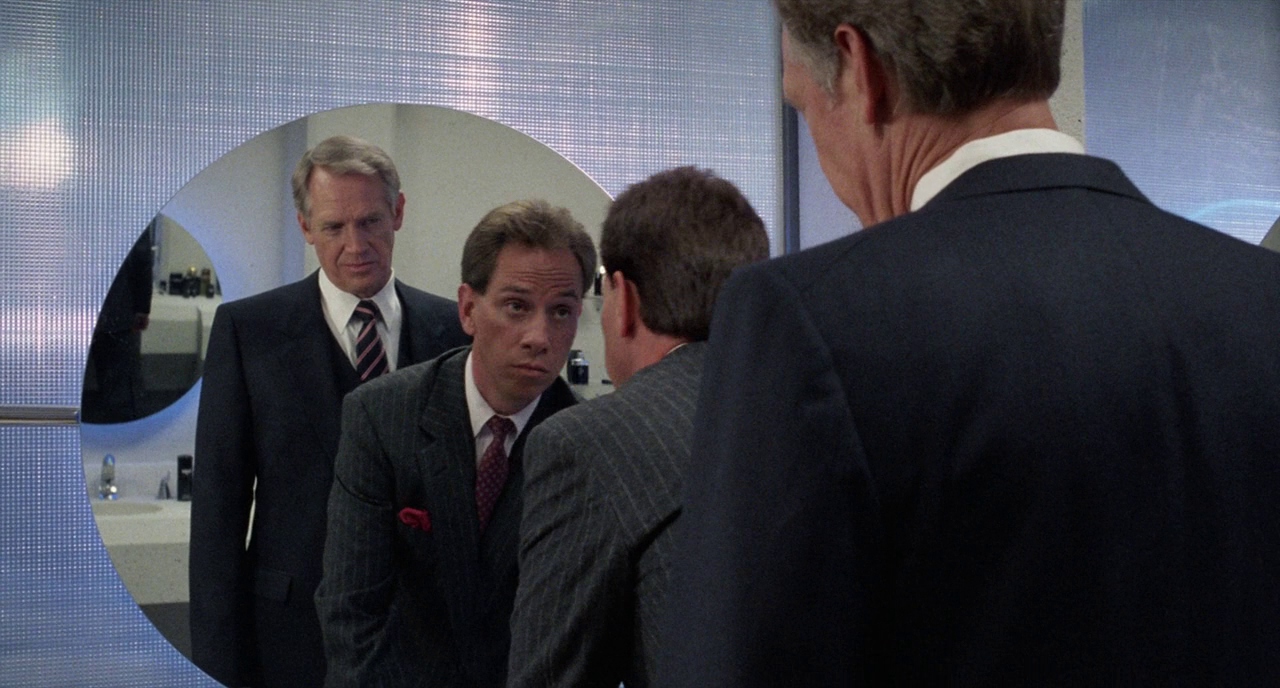
It is unclear how much of the human police officer remains in the RoboCop. His face looks like it was grafted onto a head that contains a computer instead of a brain, and all of his limbs were replaced. He eats baby food so we can assume there is some sort of digestive system, but let’s not follow the rabbit trail of analyzing how the thing actually functions biologically. More important is how the nearly anonymous protagonist connects with the audience.
The challenge of making the monotone cyborg a compelling lead is tackled in two distinctly creative ways. First, the story of RoboCop folds back into that of the deceased Murphy. He has repeated dreams of Boddicker putting a bullet into his forehead, and eventually tracks down who he was in his previous life, even visiting his family’s abandoned house and learning that his wife and child have moved to another city. Second, the film presents a number of RoboCop POV shots to put us in his head, so to speak. We are there for his awakening, for the research team’s New Year’s celebration when a lab technician kisses his tinted visor, and when his targeting system is calibrated. We see through his eyes when one of the thugs who riddled him with holes recognizes him and kickstarts his quest for uncovering his past.
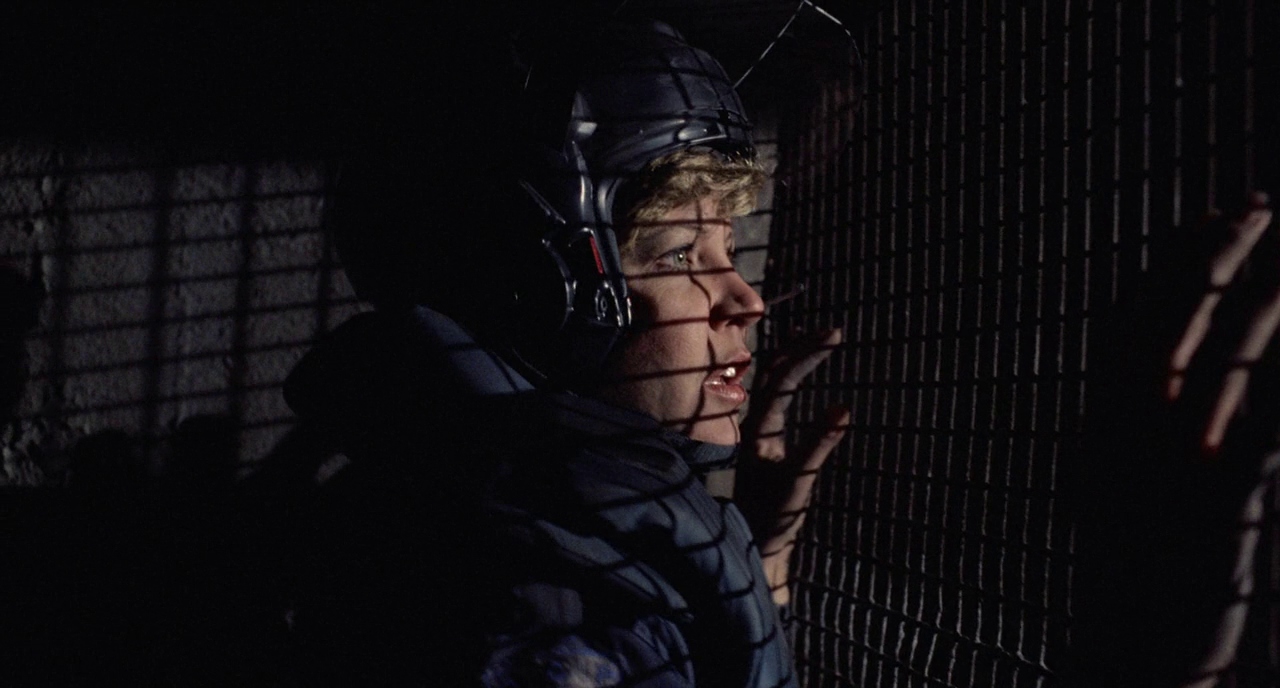
RoboCop/Murphy is aided throughout his journey by Lewis (Nancy Allen), a spunky, gum-chewing kicker of butts who spends most of the film trying to atone for her role in Murphy’s death. Together, they take down Boddicker, but RoboCop’s main target is the corrupt non-suspect Dick Jones. Murphy bursts into the boardroom and tells the executives that Dick Jones is wanted for murder but that he has been programmed with an inability to act against senior members of the company. Dick takes the Old Man hostage by holding a gun to his head, but the Old Man’s quick thinking (“Dick, you’re fired!” he shouts before elbowing Dick in the gut) nullifies the directive and allows RoboCop to blast him from a highrise window.2
Throughout the film, news anchors deliver the headlines to the audience in satirical spurts. Refreshingly, these are never presented as a character watching television; rather the editors simply cut right from a scene to the news as if it was interrupting our movie. They all have the same sarcastic tone, but that tone is delectable. Actual news is covered in a cursory fashion—ten seconds on an update of a military conflict, a casual mention that a satellite weapon misfired and destroyed tens of thousands of acres, etc.—while much more time is spent on ridiculous ads. For instance, we are shown a very long commercial for a family board game called ‘Nukem’ which involves players infiltrating one another’s territories, imposing sanctions and enforcing regime changes, until one player panics and begins launching nukes at the other countries. Verhoeven would return to satirical, subversive sci-fi twice more with Total Recall and Starship Troopers, adapting two giants of science fiction: Philip K. Dick and Robert A. Heinlein.
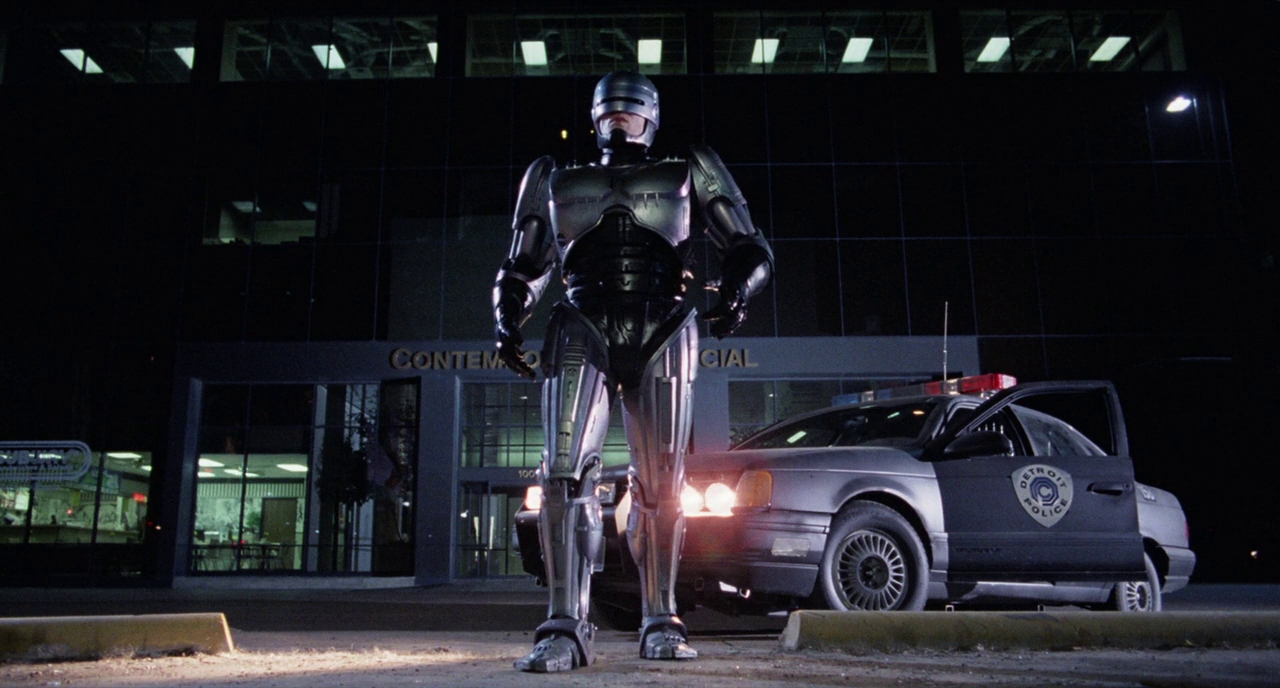
The marketing for RoboCop was bizarre and incomprehensible. Recall that this film was rated X, repeatedly, until the gore was reduced and light-hearted, nuke-your-sister commercials were added. This is firmly rated R. But it was marketed for kids! Both a toy line and a cartoon series were created to appeal to children. Films like Terminator 2 and Aliens received similar treatment, which starkly illustrates how quickly society’s values can shift.3
RoboCop is of a rare breed, offering something to chew on for the popcorn crowd, the social philosophers, and the cyberpunks alike. It has style as well as substance. The somewhat dated effects are easy to overlook—frankly, they’re kind of endearing—because the film is so forward thinking and downright prescient in other aspects. Strong writing, committed performances, and biting satire elevate RoboCop above most contemporaneous sci-fi B-movies that you may mistake it for at a glance. A big thank you to the Dutch government committees that wouldn’t subsidize Verhoeven’s work in his homeland, forcing him to try his hand in the American market!
1. Verhoeven has stated that he wanted Murphy to be a Christ-figure, hence the grisly death, the resurrection, the new body… to me it feels like they just superficially used the imagery of the crucifixion without trying to incorporate anything beyond that. Case in point: it doesn’t really work to have your Christ-figure rise from the dead and start shooting criminals in the wiener.
2. The shot of Dick Jones falling to the city street below is (in)famous for Dick’s oddly digitally elongated arms.
3. On the one hand, it’s shocking that a parent would have given their child RoboCop or Terminator toys if they knew the content of the films. On the other, what’s wrong with presenting them with something from a franchise that they will also be able to enjoy when they’re older? Most people don’t continue consuming children’s entertainment when they’re adults. Maybe it’s a good idea to introduce them to a franchise that they can “grow into.” In our current era, superheroes are for both adults and kids; franchises like Star Wars and The Lord of the Rings have products that market to both as well. I’ll admit that content control was a lot easier back then when the internet was barely a thing, but let’s be honest, watching Murphy get killed is not the worst thing a child can easily stumble upon on the internet today. Far worse is presented to children in the guise of children’s entertainment.
Sources:
“Backstory RoboCop AMC”. Youtube, RoboCop Archive. 9 June 2007.
Taylor, Drew. “10 Reasons Why The Original ‘RoboCop’ Can’t Be Beaten By The Remake”. IndieWire. 13 February 2014.